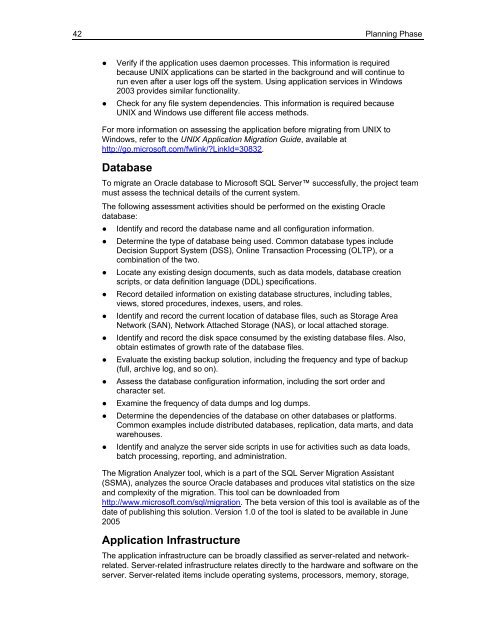Solution Guide for Migrating Oracle on UNIX to SQL Server - Willy .Net
Solution Guide for Migrating Oracle on UNIX to SQL Server - Willy .Net
Solution Guide for Migrating Oracle on UNIX to SQL Server - Willy .Net
- No tags were found...
You also want an ePaper? Increase the reach of your titles
YUMPU automatically turns print PDFs into web optimized ePapers that Google loves.
42Planning Phase●●Verify if the applicati<strong>on</strong> uses daem<strong>on</strong> processes. This in<str<strong>on</strong>g>for</str<strong>on</strong>g>mati<strong>on</strong> is requiredbecause <strong>UNIX</strong> applicati<strong>on</strong>s can be started in the background and will c<strong>on</strong>tinue <strong>to</strong>run even after a user logs off the system. Using applicati<strong>on</strong> services in Windows2003 provides similar functi<strong>on</strong>ality.Check <str<strong>on</strong>g>for</str<strong>on</strong>g> any file system dependencies. This in<str<strong>on</strong>g>for</str<strong>on</strong>g>mati<strong>on</strong> is required because<strong>UNIX</strong> and Windows use different file access methods.For more in<str<strong>on</strong>g>for</str<strong>on</strong>g>mati<strong>on</strong> <strong>on</strong> assessing the applicati<strong>on</strong> be<str<strong>on</strong>g>for</str<strong>on</strong>g>e migrating from <strong>UNIX</strong> <strong>to</strong>Windows, refer <strong>to</strong> the <strong>UNIX</strong> Applicati<strong>on</strong> Migrati<strong>on</strong> <str<strong>on</strong>g>Guide</str<strong>on</strong>g>, available athttp://go.microsoft.com/fwlink/?LinkId=30832.DatabaseTo migrate an <str<strong>on</strong>g>Oracle</str<strong>on</strong>g> database <strong>to</strong> Microsoft <strong>SQL</strong> <strong>Server</strong> successfully, the project teammust assess the technical details of the current system.The following assessment activities should be per<str<strong>on</strong>g>for</str<strong>on</strong>g>med <strong>on</strong> the existing <str<strong>on</strong>g>Oracle</str<strong>on</strong>g>database:● Identify and record the database name and all c<strong>on</strong>figurati<strong>on</strong> in<str<strong>on</strong>g>for</str<strong>on</strong>g>mati<strong>on</strong>.● Determine the type of database being used. Comm<strong>on</strong> database types includeDecisi<strong>on</strong> Support System (DSS), Online Transacti<strong>on</strong> Processing (OLTP), or acombinati<strong>on</strong> of the two.● Locate any existing design documents, such as data models, database creati<strong>on</strong>scripts, or data definiti<strong>on</strong> language (DDL) specificati<strong>on</strong>s.● Record detailed in<str<strong>on</strong>g>for</str<strong>on</strong>g>mati<strong>on</strong> <strong>on</strong> existing database structures, including tables,views, s<strong>to</strong>red procedures, indexes, users, and roles.● Identify and record the current locati<strong>on</strong> of database files, such as S<strong>to</strong>rage Area<strong>Net</strong>work (SAN), <strong>Net</strong>work Attached S<strong>to</strong>rage (NAS), or local attached s<strong>to</strong>rage.● Identify and record the disk space c<strong>on</strong>sumed by the existing database files. Also,obtain estimates of growth rate of the database files.● Evaluate the existing backup soluti<strong>on</strong>, including the frequency and type of backup(full, archive log, and so <strong>on</strong>).● Assess the database c<strong>on</strong>figurati<strong>on</strong> in<str<strong>on</strong>g>for</str<strong>on</strong>g>mati<strong>on</strong>, including the sort order andcharacter set.● Examine the frequency of data dumps and log dumps.● Determine the dependencies of the database <strong>on</strong> other databases or plat<str<strong>on</strong>g>for</str<strong>on</strong>g>ms.Comm<strong>on</strong> examples include distributed databases, replicati<strong>on</strong>, data marts, and datawarehouses.● Identify and analyze the server side scripts in use <str<strong>on</strong>g>for</str<strong>on</strong>g> activities such as data loads,batch processing, reporting, and administrati<strong>on</strong>.The Migrati<strong>on</strong> Analyzer <strong>to</strong>ol, which is a part of the <strong>SQL</strong> <strong>Server</strong> Migrati<strong>on</strong> Assistant(SSMA), analyzes the source <str<strong>on</strong>g>Oracle</str<strong>on</strong>g> databases and produces vital statistics <strong>on</strong> the sizeand complexity of the migrati<strong>on</strong>. This <strong>to</strong>ol can be downloaded fromhttp://www.microsoft.com/sql/migrati<strong>on</strong>. The beta versi<strong>on</strong> of this <strong>to</strong>ol is available as of thedate of publishing this soluti<strong>on</strong>. Versi<strong>on</strong> 1.0 of the <strong>to</strong>ol is slated <strong>to</strong> be available in June2005Applicati<strong>on</strong> InfrastructureThe applicati<strong>on</strong> infrastructure can be broadly classified as server-related and networkrelated.<strong>Server</strong>-related infrastructure relates directly <strong>to</strong> the hardware and software <strong>on</strong> theserver. <strong>Server</strong>-related items include operating systems, processors, memory, s<strong>to</strong>rage,
















